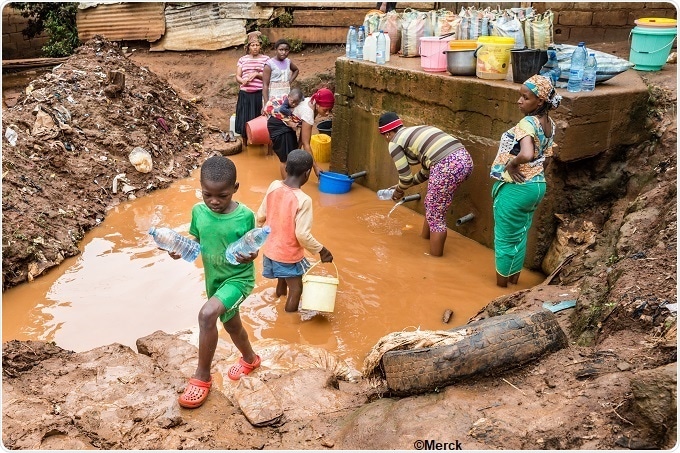Schistosomiasis is a parasitic disease, sometimes called bilharzia or snail fever. The disease impacts a huge number of people around the world, over 230 million people are infected with one of the schistosome species, the parasitic worms that causes the disease.
Most of those cases, over 90%, are found in Africa, particularly in rural areas of Africa where people don't have access to good sanitation or a clean water supply.
Schistosomiasis | How does this neglected tropical disease spread?
What are the main symptoms of schistosomiasis? Can it be fatal?
The worms that infect humans can be male or female, and are quite large, they're about 1cm long. This group of parasites live within the blood vessels around by the gut for some species, or down by the blood vessels surrounding the bladder for others. Many worms can infect an individual patient at one time and they live for quite some time.
The worms themselves don't cause much damage, but the eggs that they produce do. The parasites living within the body continue their life cycle and produces eggs, which pass through the bladder or gut wall and into the urine or feces. When they come into contact with water, this will enable transmission of the parasites.
The eggs that don’t escape cause the symptoms of schistosomiasis, this is body reacting to the eggs, because many of the eggs will get trapped in other nearby tissues, particularly the liver and the bladder wall.
Granulomas form around the eggs, which causes the pathology seen. Symptoms include anemia, because there's loss of blood, as well as growth stunting, decreased physical fitness, and then also symptoms related to the specific organ affected, such as portal hypertension, kidney failure, bladder cancers, in cases of long term infection. WHO estimates that there are about 200 000 deaths globally each year due to schistosomiasis

How can people become infected with schistosomiasis?
People are infected through water, it's a trematode parasite, and it spends part of its life in fresh water snails. The parasites and the snails have a very specific relationship. Only some snails are responsible for the transmission of the schistosome parasite.
Adult worms live in people, primarily in children, as part of their life cycle. As I mentioned, eggs are produced and are expelled, either in urine or feces, depending upon the species of Schistosoma, which then continue their journey to a water supply, where the eggs will hatch. They are then in free-swimming form, which we call a miracidium, and at this stage of its life cycle, the parasite actively seeks out and penetrates a fresh water snail.
Once within the snail, it multiplies and reproduces via asexual reproduction. Twenty eight to 30 days later, for every infective stage that went into the snail, many hundreds and thousands of further infective stages we call cercariae emerge, and these cercariae move back into the next human host by penetrating directly through the skin. They're tiny, they're microscopic, people wouldn't notice.
Populations living in rural areas often have daily contact with water, either for collecting drinking water, or for washing clothes, washing themselves, children playing. When people are in contact with the water, the schistosome parasite is able to penetrate through the skin.
Once back in the human host the parasite grows and develops, male and female worms pair together and migrate to the egg laying sites, the bladder or intestines, and that’s the life cycle. It's a disease that doesn't go from child to child, it can't pass from person to person, it has to go through the snail host.

Why is infection especially high in children?
It's most likely because children, in these rural areas, have a lot more water contact through playing. When it's very hot and there's not a lot to do, it's fun to go and splash around in the local pools and rivers.
There's very little immunity to the disease and to the parasites at the young age. Unfortunately, it's a disease that can infect the preschool age child, so we can see infections at young ages, one or two years of age.
How can schistosomiasis be prevented?
It can be prevented by trying to break the life cycle. We can do that in a number of ways such as, chemotherapy using the drug praziquantel, which can be used and is used extensively to treat infected human populations, so that kills the adult worms. The drug doesn't always get a 100% cure rate, but it kills most of the worms in most places.
Other prevention methods include stopping people from coming into contact with water in high risk areas, and by making sure that health education is good.
We can also try and take the snail out of the equation, and try and control snails in some of these areas. However, this is an extremely difficult thing to do, but it's something that has been successful in some places.
Another important way is through improvement of water and sanitation, to minimize the time that people need to go into the local water etc.

What more needs to be done to tackle schistosomiasis?
Schistosomiasis affects many people, mainly in poor regions of the world where there is a lack of clean water and toilets. We have a drug that works and there's a massive drug donation from Merck, who are supplying up to 250 million praziquantel tablets a year and donating those tablets to endemic areas. This provides the opportunity to treat 100 million school children.
Merck also developing a pediatric formulation of the drug because at the moment, the tablet itself is big and chalky, which is difficult to swallow, especially for young children.
Although this is great progress, improvements for other interventions are also required, for example, can we do more to control snails and break that life cycle? Can we do more to improve water and sanitation? Can we change behavior so there is less water contact?
Do you think it will be possible to eliminate schistosomiasis one day? How far away are we from this goal?
We're working towards elimination. The drug donations that have taken place are great. There has been a lot of interest from some of the big foundations to control and eliminate this debilitating disease.
My work, for example, is funded in part by the Bill and Melinda Gates Foundation through the University of Georgia SCORE programme. We've got good investment coming in from the UK government, from DFID (Department for International Development), and USAID (United States Agency for International Development).
Schistosomiasis is a neglected tropical disease (NTD) and a couple of weeks ago, there was a five-year celebration of the achievements that have taken place in WHO Geneva, since the London Declaration on Neglected Tropical Diseases in 2012. There's a big momentum at the moment for control of NTDs, and that gives us some hope that we can provide more resources and move towards elimination of schistosomiasis.
Control programmes run by Ministries of Health use a process called mass drug administration (MDA) whereby drugs are given to all children without diagnosis. Many programmes run through the schools and MDA has to be done on a regular basis because in many of these rural settings, children rapidly become reinfected. Of course there are challenges especially reaching the children who do not attend school.
We have a program in Zanzibar where they’re using different interventions, snail control and behavior change, we are also increasing the mass drug administration from once a year to twice a year, so the whole population gets the possibility of treatment every six months.
After about five years, we're getting down to some very low levels of infection using these different interventions, which is good news. However, we know that across Africa, and not just in Zanzibar, this disease is highly focal. It depends heavily on where the snails are and where the people-water contacts are, and so you often need to develop different approaches in different areas. In Zanzibar and elsewhere, we see what we call “hot spots”.
Hot spots of infection are where the disease persists despite our disease prevention methods. We need to look at those areas more carefully, so that even in a very small island like Zanzibar, we'll get places where we're doing very well and we may no longer be seeing cases in some of the schools, for example. But there'll be one or two places where disease prevalence is still higher than it should be and those areas need to be more heavily scrutinized.

What are the main challenges to overcome?
There are a lot of challenges to overcome, now we've got this massive donation from Merck we need to get more resource for implementation. There is one group in London, the Schistosomiasis Control Initiative (SCI), which does a lot of implementation across Africa and raises money from government and a lot of philanthropic private money goes into SCI, but there is lot to do and many countries need help to improve implementation.
We need to make sure that the governments are fully informed because all of the work is implemented with the Ministry of Health and it's them who are giving the tablets. We need to make sure that control programs, integrate schistosomiasis control with other diseases. We have other parasites, especially the worms that live in the gut, the soil-transmitted helminths, that can be treated with different drugs at the same time as treatment for schistosomiasis.
It also comes back to resources, governments need to take some responsibility and not rely completely on donations and external help. When resources are extremely limited, there needs to be correct prioritization of different diseases, but that's a huge challenge. We need better capacity building in country and more people on the ground, people who can understand the transmission, and some of the snails involved and help expand some of the control programs.
Egypt has been a country that's had a long history of control. Some of the records in Egypt go back to the hieroglyphics in ancient Egypt, and so it's been there for a very long time. Now Egypt is just about to embark on an elimination program, which illustrates a good example that things can be done in some settings.
Schistosomiasis was found in Japan many years ago, but with development, improved water supplies, and the quality of life improvements in general, that has been overcome. China is doing a very good job at elimination and is hoping to achieve that by 2025. It's very high on their priority list and there's a lot of resource and manpower going into control in China.
What impact do you hope your research will have?
We'd like to eliminate schistosomiasis. Here at the Natural History Museum, we have a research group which is also a World Health Organization collaborating center, and part of our interests stem from being interested in biology, looking at what we call the host parasite interactions, and looking to see how different parasites interact with their snail hosts. How can we identify schistosomes, the parasites that cause schistosomiasis? How can we diagnose those infections? How can we identify the snails that carry the infection from others? What can be done about it?
There has just recently been a Nature Communications paper out on the snail genome. This is the first big paper on the snail genome, a snail called Biomphalaria, which transmits intestinal schistosomiasis. Learning more about the genomes of both parasites and snails is one of the things we try and do at the Natural History Museum. We hope this will lead to better interventions and better control.
At present there is only one drug available for treatment and there is the potential to get future resistance to it. We need to be aware of alternatives. There are currently no vaccines for schistosomiasis and so there's still a huge amount to do. Trying to control a very complicated parasite with a large genome, it's a large worm, living in a very hostile environment. It lives in the blood vessels of man and it can survive all the immune responses that are thrown against it.
Our research and other research that's going on is trying to find better ways to undertake control, to find better tools. Better tools to diagnose the disease, better tools for snail control, better tools for treatment, and also better ways of implementing treatment.
The Zanzibar elimination study I mentioned is interesting in the sense that we have to look very carefully at the use of the drug and how is it delivered. The MDA programs, take a lot of work on the ground. There is a a lot of logistical work necessary for a Ministry of Health in distributing tablets to many different people at one particular time.
Here at the Natural History Museum, we are primarily biologists interested in host-parasite interactions, some of the evolutionary questions associated with how these parasites have diverged and what's taking place now. At the same time, we have become quite heavily involved with what we would call operational research, working with Ministries of Health to implement better control and move towards elimination of schistosomiasis.
Changes in climate and environment and movement of people will impact on the distribution of schistosomiasis. There's recently been an outbreak of schistosomiasis in Corsica. The snail host has been present in Corsica for a very long time, but the infection has not. With the movement of people, the parasite has been introduced, and we suspect the parasite came from Senegal. We can tell that from molecular typing studies.
There were over a hundred French and German tourists and some local people that became infected with schistosomiasis, unexpectedly. That's of concern, the parasite is primarily found in Africa, with tropical regions, but if the snail is there, you've always got the possibility of introduction.
Where can readers find more information?
About Professor David Rollinson
 David Rollinson is a Merit Research Scientist at the Natural History Museum in London and is the Director of a WHO Collaborating Centre for schistosomiasis. He will shortly be taking up the role of Director of the Global Schistosomiasis Alliance (GSA).
David Rollinson is a Merit Research Scientist at the Natural History Museum in London and is the Director of a WHO Collaborating Centre for schistosomiasis. He will shortly be taking up the role of Director of the Global Schistosomiasis Alliance (GSA).
David and his team work with colleagues in many parts of Africa including Senegal, Niger, Cote d’Ivoire, Tanzania and Zanzibar to better understand schistosome parasites and their freshwater snail hosts in order to control and eventually eliminate this debilitating disease. David is a biologist by training with a long term interest in parasites and their fascinating life cycles.